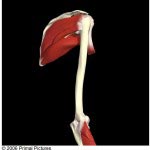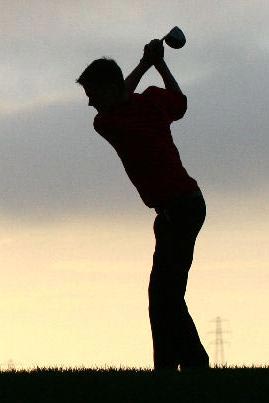The Shoulder: Common Injuries in Golf
Shoulder injuries can be a real pain. There are many kinds of injuries. In this lesson, we will take up a variety of shoulder dysfunctions and the injuries they cause. Shoulder injuries are interesting because they generally come from overuse or improper use and from poor stability/mobility patterns of the thoracic spine and shoulder girdle. When the thoracic spine (which is supposed to be mobile) becomes immobile, this leads to excessive mobility of the shoulder blade. If this happens, the shoulder joint’s response is to create stability for the arm rather than allowing mobility of the arm. The result seems to be role reversal in the thoracic spine, scapula, and shoulder that is the root of many shoulder problems.
Rotator cuff tendonitis is nothing more than inflammation of the tendons of the rotator cuff. This inflammation is generally caused by overuse or impingement. Most commonly, this is the supraspinatus muscle. This muscle sits at the top of the shoulder blade on the back and runs directly through the sub-acromial space. Because of its position, it is very susceptible to compression (impingement) between the humeral head and the acromion. Unchecked impingement can lead to tearing or shredding of the tendons of the rotator cuff muscles. This is a real problem for the golfer. If you tear these tendons, you will be out of the game for about 6 months.

When the shoulder blade becomes unstable on the ribcage, due to thoracic spine rigidity, the muscles of the rotator cuff become over active. They “try” to create stability in the shoulder so the arm can move. There is a rule in the body when it comes to muscles: a muscle cannot be a stabilizer and a mover at the same time. When a muscle that is a mover “tries” to act as a stabilizer, it generally becomes irritated and inflamed and a tendonitis develops because it was not designed to act in this way.
If you want to prevent this type of shoulder injury, you must have a mobile thoracic spine, stable shoulder blade and mobile shoulder. This will stop shoulder injuries. It will also cure some golf maladies like “flying elbow”, “limited arc length” and deceleration and “flipping” of the club.

Bursitis is the inflammation of a bursa. This inflammation is caused by excessive irritation and poor mechanics of the structures that the burae are guarding. Remember that a bursa is a fluid-filled sac. Its job is to cushion the ride of muscles and tendons as they glide over one another or over bones. If the mechanical pressures are too much, the bursa will become inflamed and cause pain and compensation of your swing motion. Once again it comes back to shoulder complex mechanics. Balanced mechanical function prevents injuries and promotes good motion in the golf swing.

Arthritis is a process of wearing out of the shoulder joint. Many attribute this disorder to aging, other injuries and poor conditioning. All are correct. There is, however, another reason: improper use of the body part, in this case, the shoulder. If there are muscle imbalances, shoulder girdle imbalances or a limited range of motion in a shoulder or thoracic spine, the shoulder is put under great stress. An unbalanced shoulder girdle causes asymmetrical loading of the shoulder joint. It will, over time, lead to wearing out and change in shape of the shoulder joint.
Just because you are older, you do not have to have arthritis. With proper activity, including training that promotes symmetry in the shoulder girdle and the muscles of the trunk, arthritis can mostly be prevented. Just because your doctor tells you that you have a little arthritis, this does not mean it is the cause of your shoulder pain.

The bottom line is that self-diagnosis rarely works. If you have shoulder pain, you could have any of these disorders. All of these disorders are aggravated by imbalances in the muscles of the shoulder girdle, thoracic spine and shoulder joint. Remedying these imbalances in most cases will reduce the strain on the structures of the shoulder complex and lead to less pain.
If you try these exercises and you find them to be too challenging or uncomfortable, do not continue, until you have consulted with your physician. All exercises for golf should be customized to your needs after a proper evaluation.
Come In and See Us
Want to take your golf to the next level? Our FitGolf® Trainers are experts at working one-on-one with you to tailor a training program to meet the specific needs of your body and help you achieve the results you are hoping to see in your golf.
Want More Resources?
Looking for more exercise resources, blog posts or monthly golf-specific exercise content sent straight to your inbox?
